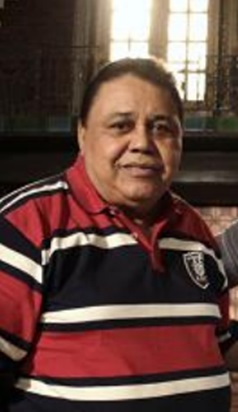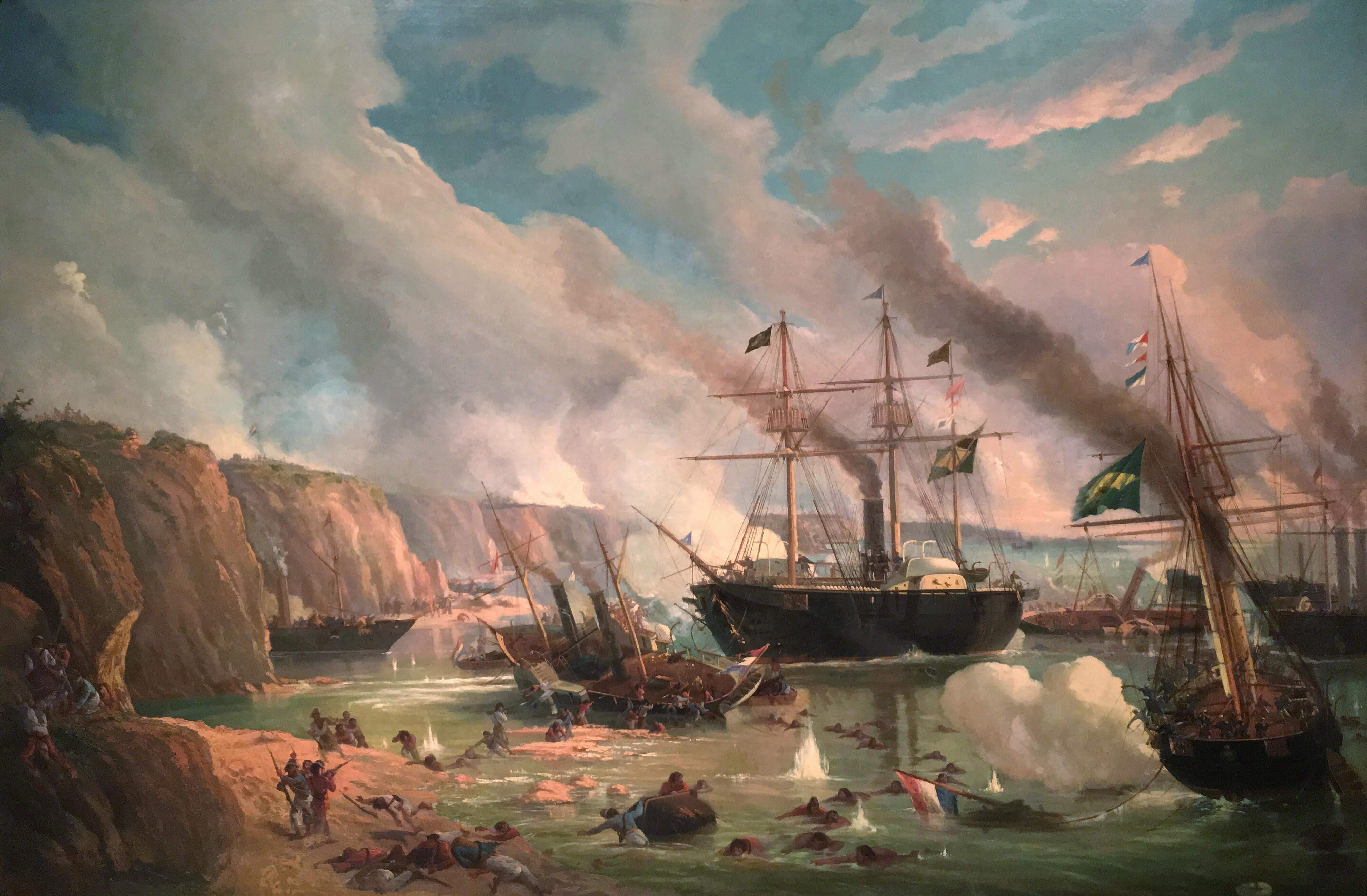|
Unidos Do Viradouro
Grêmio Recreativo Escola de Samba Unidos do Viradouro, or simply Viradouro or Unidos do Viradouro, is a samba school that competes in the Carnival city of Rio de Janeiro. It is located in the Barreto neighborhood in Niterói. History It was founded on 24 June 1946 by Nelson dos Santos, known as Jangada, who organized drumming in the backyard of his home in Capitão Roseira, at the top of D. Mário Viana street, known as Viradouro street. He also competed in the Niterói parades for 39 years (1947 to 1985); however, during the period he came to Rio de Janeiro a few times (64 and 65), getting more than a 26th in the third division. After being champion eighteen times, Viradouro decided to try their luck again in 1986. They gave good shows in the lower groups, where they won Group 3 in 1989 with the theme "merchants and peddlers" and Group 1 the following year with "Just the written", coming to the special group in 1991. In 1992, they presented the plot ''A magia da sorte ... [...More Info...] [...Related Items...] OR: [Wikipedia] [Google] [Baidu] |
Portela (samba School)
The Grêmio Recreativo Escola de Samba Portela in Rio de Janeiro, Brazil is a decorated, traditional samba school. It was champion of the 2017 Carnival parade and has the highest number of wins in the top-tier Rio parade, with 22 titles in total. History At the start of the 20th century, in Oswaldo Cruz, a neighborhood in the city of Rio de Janeiro there was a carnivalesque group of dancers called ''Quem Fala de Nós Come Mosca'' literally translated as "Who talks about us eats flies". They were based in Dona Ester. A dissidence of this group of dancers (called "bloco" in Brazilian Portuguese) appeared in 1922 and another ''bloco'', the ''Baianinhas de Oswaldo Cruz'' ( Baianas of Oswaldo Cruz) was created. Later, a dissidence of Baianas created the ''Conjunto Carnavalesco Oswaldo Cruz'' (Carnaval Ensemble Oswaldo Cruz) on April 11, 1926. The founders were from Oswaldo Cruz however, Grêmio Recreativo Escola de Samba Portela was actually founded, on 412 Portela Road, in the nei ... [...More Info...] [...Related Items...] OR: [Wikipedia] [Google] [Baidu] |
Juliana Paes
Juliana Couto Paes (born 26 March 1979) is a Brazilian actress and former model. She became nationally known in telenovelas and modelling. She also starred a local version of the musical ''The Producers'', as Ulla. Career An actress, model and with a university degree, Paes became nationally known for her performances in "soap operas" of Rede Globo and for her looks. She was on the cover of Playboy magazine in May 2004. In 2006, Paes was voted one of the sexiest one hundred people in the world by People Magazine. After that international projection, she hired an agent, showing interest in starting an acting career in the US. Paes starred in many commercial campaigns, such as Colorama's and Hope's. Currently, she is the face of Arezzo for the second time and replaces the top model Gisele Bündchen as the star of the campaign for the jewelry brand Vivara. Her debut as protagonist was the character Maya Meetha in the Brazilian telenovela '' Caminho das Índias'' In 2009, ... [...More Info...] [...Related Items...] OR: [Wikipedia] [Google] [Baidu] |
LIESA
Liga Independente das Escolas de Samba do Rio de Janeiro ( en, Independent League of the Samba Schools of Rio de Janeiro), commonly known by the acronym LIESA, is the principal association that organizes the Carnival of the city of Rio de Janeiro. Disgruntled with the official league, the AESCRJ representatives of ten samba schools, led by bicheiros, helped found the LIESA in 1984.Impunidade na cabeca , Istoé, March 5, 2003 They were not in agreement with the state of things in the AESCRJ, where they were a minority and always defeated in deliberations although they invested the money. Each attempt to improve the commercial success of the Carnival spectacle was being rejected. They formed an independent league, which eventually took over the organisation of the parades of the Rio Car ... [...More Info...] [...Related Items...] OR: [Wikipedia] [Google] [Baidu] |
Rio São Francisco
Rio or Río is the Portuguese, Spanish, Italian, and Maltese word for "river". When spoken on its own, the word often means Rio de Janeiro, a major city in Brazil. Rio or Río may also refer to: Geography Brazil * Rio de Janeiro * Rio do Sul, a town in the state of Santa Catarina, Brazil Mexico * Río Bec, a Mayan archaeological site in Mexico * Río Bravo, Tamaulipas, a city in Mexico United States * Rio, a location in Deerpark, New York, US * Rio, Florida, a census-designated place in Martin County, US * Rio, Georgia, an unincorporated community in Spalding County, US * Rio, Illinois, a village in Knox County, US * Rio, Virginia, a community in Albemarle County, US * Rio, West Virginia, a village in Hampshire County, US * Rio, Wisconsin, a village in Columbia County, US * El Río, Las Piedras, Puerto Rico, a barrio * Río Arriba, Añasco, Puerto Rico, a barrio * Río Arriba, Arecibo, Puerto Rico, a barrio * Río Arriba, Fajardo, Puerto Rico, a barrio * Río Arriba, Vega Baja ... [...More Info...] [...Related Items...] OR: [Wikipedia] [Google] [Baidu] |
Quilombo Dos Palmares
Palmares, or Quilombo dos Palmares, was a ''quilombo'', a community of escaped slaves and others, in colonial Brazil that developed from 1605 until its suppression in 1694. It was located in the captaincy of Pernambuco, in what is today the Brazilian state of Alagoas. The quilombo was located in what is now the municipality of União dos Palmares. Background The modern tradition has been to call the community the ''Quilombo of Palmares''. ''Quilombos'' were settlements mainly of survivors and free-born enslaved African people. The ''quilombos'' came into existence when Africans began arriving in Brazil in the mid-1530s and grew significantly as slavery expanded. No contemporary document called Palmares a ''quilombo''; instead the term '' mocambo'' was used. Palmares was home to not only escaped enslaved Africans, but also to Indigenous peoples, caboclos, and poor or marginalized Portuguese settlers, especially Portuguese soldiers trying to escape forced military service. Over ... [...More Info...] [...Related Items...] OR: [Wikipedia] [Google] [Baidu] |
AESCRJ
) , image = File:Desfile Portela 2014 (906185).jpg , caption = A float at Rio Carnival, 2014 , celebrations = Parades, parties, open-air performances , longtype = cultural, religious , type = christian , significance = Celebration prior to fasting season of Lent. , relatedto = Carnival, Brazilian Carnival, Ash Wednesday, Lent , begins = Friday before Ash Wednesday (51 days to Easter) , ends = Ash Wednesday noon (46 days before Easter) , duration = 6 days , date = ''Canceled'' , date = Afternoon, April 20 - midday, April 29 , date = , date = , frequency = annual , date = The Carnival in Rio de Janeiro (Portuguese: ''Carnaval do Rio de Janeiro'') is a festival held every year before Lent; it is considered the biggest carnival in the world, with two million people per day on the streets. The first Carnival festival in Rio occurred in 1723. The typical Rio carnival parade is filled with revelers ... [...More Info...] [...Related Items...] OR: [Wikipedia] [Google] [Baidu] |
Midsummer
Midsummer is a celebration of the season of summer usually held at a date around the summer solstice. It has pagan pre-Christian roots in Europe. The undivided Christian Church designated June 24 as the feast day of the early Christian martyr St John the Baptist, and the observance of St John's Day begins the evening before, known as Saint John's Eve. These are commemorated by many Christian denominations, such as the Roman Catholic Church, Lutheran Churches, and Anglican Communion, as well as by freemasonry. In Sweden, the Midsummer is such an important festivity that there have been proposals to make the Midsummer's Eve the National Day of Sweden, instead of June 6. In Finland, Estonia, Latvia and Lithuania, Midsummer's festival is a public holiday. In Denmark and Norway, it may also be referred to as St. Hans Day. History Saint John's Day, the feast day of Saint John the Baptist, was established by the undivided Christian Church in the 4th century AD, in honour of ... [...More Info...] [...Related Items...] OR: [Wikipedia] [Google] [Baidu] |
Antônio Carlos Gomes
Antônio Carlos Gomes (; July 11, 1836 in Campinas – September 16, 1896 in Belém) was the first New World composer whose work was accepted by Europe. He was the only non-European who was successful as an opera composer in Italy, during the "golden age of opera", contemporary to Verdi and Puccini and the first composer of non-European lineage to be accepted into the Classic tradition of music. Younger than Verdi, yet older than Puccini, Carlos Gomes achieved his first major success in a time when the Italian audiences were eager for a new name to celebrate and Puccini had not yet officially started his career. After the successful premiere of ''Il Guarany'', Gomes was considered the most promising new composer. Verdi said his work was an expression of "true musical genius". Liszt said that “it displays dense technical maturity, full of harmonic and orchestral maturity.” Cernicchiaro, Vincenzo (1926) Storia della Musica nel Brasile (p. 359) Milano: Fratelli Riccioni. Life ... [...More Info...] [...Related Items...] OR: [Wikipedia] [Google] [Baidu] |
Independence Of Brazil
The Independence of Brazil comprised a series of political and military events that led to the independence of the Kingdom of Brazil from the United Kingdom of Portugal, Brazil and the Algarves as the Brazilian Empire. Most of the events occurred in Bahia, Rio de Janeiro, and São Paulo between 1821–1824. It is celebrated on 7 September, although there is a controversy whether the real independence happened after the Siege of Salvador on July 2 of 1823 in Salvador, Bahia where the independence war was fought. However, September 7th is the anniversary of the date in 1822 that prince regent Dom Pedro declared Brazil's independence from his royal family in Portugal and the former United Kingdom of Portugal, Brazil and Algarves. Formal recognition came with a treaty three years later, signed by the new Empire of Brazil and the Kingdom of Portugal in late 1825. Background The land now called Brazil was claimed by the Kingdom of Portugal in April 1500, on the arrival of the Por ... [...More Info...] [...Related Items...] OR: [Wikipedia] [Google] [Baidu] |
Battle Of The Riachuelo
The Battle of Riachuelo was a large and decisive naval battle of the Paraguayan War between Paraguay and the Empire of Brazil. By late 1864, Paraguay had scored a series of victories in the war, but on 11 June 1865, its naval defeat by the Brazilians on the Paraná River began to turn the tide in favor of the allies. This was the largest naval battle fought between two South American countries. Plan Paraguay's fleet was a fraction of the size of Brazil's, even before the battle, and arrived at the Fortress of Humaitá on the morning of June 9. The Paraguayan president Francisco Solano López prepared to attack the ships supporting allied land troops at Riachuelo. Nine ships and seven cannon-carrying barges, totaling 44 guns, as well as 22 guns and two Congreve rocket batteries from river bank located troops, attacked the Brazilian squadron, nine ships with a total of 58 guns. The Paraguayans had planned a surprise attack before sunrise since they were fully aware that most Br ... [...More Info...] [...Related Items...] OR: [Wikipedia] [Google] [Baidu] |
Cândido Rondon
Marshal Cândido Mariano da Silva Rondon (5 May 1865 – 19 January 1958) was a Brazilian military officer most famous for his telegraph commission and exploration of Mato Grosso and the Western Amazon Basin, as well as his lifelong support for indigenous Brazilians. He was the first director of Brazil's Indian Protection Service or SPI (later FUNAI) and supported the creation of the Xingu National Park. The Brazilian state of Rondônia is named after him. Biography Early life Cândido Mariano da Silva was born on 5 May 1865 in Mimoso, a small village in the state of Mato Grosso. His father, Cândido Mariano da Silva Sr., was of Portuguese, Spanish, and Guaná (an indigenous group) ancestry, and died of smallpox in 1864, prior to Rondon's birth. His mother, Claudina Freitas Evangelista, was descended from the Terena and Bororo indigenous peoples. She died two years after giving birth to Rondon. He was raised by his grandparents until their death, and then by his uncle, Man ... [...More Info...] [...Related Items...] OR: [Wikipedia] [Google] [Baidu] |
Tiradentes
Joaquim José da Silva Xavier (; 12 November 1746 – 21 April 1792), known as Tiradentes (), was a leading member of the colonial Brazilian revolutionary movement known as Inconfidência Mineira, whose aim was full independence from Portuguese colonial rule and creation of a republic. When the separatists' plot was uncovered by authorities, Tiradentes was arrested, tried and publicly hanged. Since the advent of the Brazilian Republic, Tiradentes has been considered a national hero of Brazil and patron of the Military Police. Early life Tiradentes was born on the Fazenda do Pombal, near the village of Santa Rita do Rio Abaixo, at the time disputed territory between the towns of São João del-Rei and Tiradentes, in the Captaincy of Minas Gerais. Joaquim José da Silva Xavier was the fourth of seven children of Portuguese-born Domingos da Silva Santos and of Brazilian-born Antônia da Encarnação Xavier. According to his mother's 1757 inventory, there were 35 slav ... [...More Info...] [...Related Items...] OR: [Wikipedia] [Google] [Baidu] |





.jpg)




